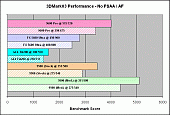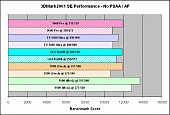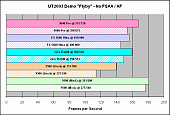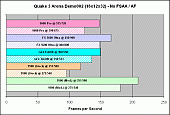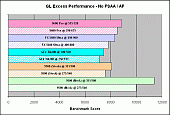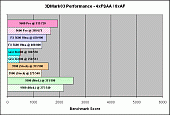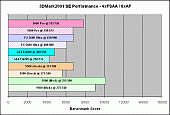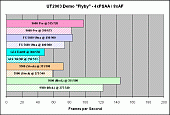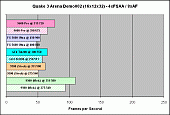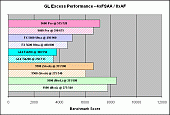| BENCHMARK RESULTS: TABLES & GRAPHS |
The results obtained from the completed testing is summarized in the following data table and charts. Two charts are shown for each benchmark test--one with antialiasing and anisotropic filtering turned off, and, beneath it, a second chart with those two parameters set to 4x and 8x, respectively. Each pair of charts is plotted on the same numerical scale to facilitate comparison. On each chart, results are given for each video card at default clock settings and overclocked. Here are the data and charts:
Benchmark Result Summary Table

Benchmark Result Charts
(Click on charts to see full size version)
| ANALYSIS & COMMENTARY |
Firstly, some observations on the image quality of the four cards: It may be a bit subjective, but I definitely found the Radeon cards to be a cut above the Nvidia cards for overall image quality. The 9600 Pro, in particular, seemed to give outstanding appearance. Text and images looked somewhat crisper, and color saturation was better. I should also mention that the image quality with AA and AF enabled was clearly superior for the Radeon cards. There were still "jaggies" slightly visible on diagonal lines and surfaces with the Nvidia cards at 4x AA, while diagonals on the Radeons appeared noticeably smoother. This may not be a big concern, especially in fast moving "action" games, but it bears mentioning.
As far as rendering performance goes, the data and charts clearly show the superiority of the modified Radeon 9500, which was the top performer in every test. This is not surprising, as it was running exactly as a 9700 would, and the impressive 3D power of those cards is well known. But, as mentioned at the outset, that wasn't really the comparison we were looking for, and the data is included primarily to provide a benchmark of high-end video card performance vs. the mid-range cards tested here.
A bit surprising was the performance of the Geforce4 Ti4200. As the oldest card and technology in the group, it would be expected to be the laggard. However, it didn't finish last in every test, by any means. It brought up the rear in 3DMark03, as expected, because it doesn't support DX9 features as the other two cards do. And it didn't do well in the GL Excess OpenGL synthetic benchmark. But other than that, it managed a number of 3rd place finishes in the other three benchmarks, and even one 2nd.
The really interesting comparisons are between the stock Radeon 9500, FX 5600 Ultra, and the 9600 Pro. The 9500 and FX 5600 Ultra turn out to perform quite comparably overall. The FX 5600 has a clear edge when antialiasing and anisotropic filtering are off, but the 9500's better AA and AF technology push it in front when these features are dialed up. But the 9600 Pro consistently outperforms both cards, scoring better in 17 of the 20 total tests run. Let's take a look at some of the key performance factors more closely.
Overall Rendering Speed - Using the Geforce4 Ti4200 card as the baseline, I pooled all of the benchmark data and calculated the speed of each card relative to it. The modified Radeon 9500 tops the list (as expected) at 130% faster, and the 9600 Pro is the clear runner-up, at 76% faster. The stock 9500 and FX 5600 are in a virtual dead heat at 46% and 45% faster, respectively. Most of this speed differential vs. the Ti4200 comes with the AA & AF turned on. With those settings off, the stock 9500 and FX 5600 are less than 20% faster overall than the old Ti4200, and the 9600 Pro has a more substantial 34% advantage.
Overclocking Benefit - The Radeon 9500 shows the biggest performance benefit from overclocking, with speed increased by 18% when run as the stock card, though this decreased to 13% when run with the hacked drivers as a 9700. The Powercolor 9600 Pro was next at 14%, driven primarily by an impressive core speed increase of nearly 30%. Both Nvidia cards gave about a 10% increase in overall benchmark results when overclocked. This reflects the fact that their core and memory clockspeed increases weren't as large on a percentage basis as was achieved for the Radeon cards. So if you like that "something for nothing" feeling, you'll get more of it from the two Radeons than either of the two Nvidia offerings, at least among these particular brands and models. It's possible you might be able to get a bit more speed out of the FX 5600 than the Gainward "enhanced" settings of 450MHz core and 900MHz memory, but I doubt that it would be significant. I tried moving the core clock up to 470MHz and immediately ran into lock-ups. And raising the memory clock to 925MHz produced artifacts and screen corruption. So it looks like Gainward already has the card pushed pretty close to its limits at the "enhanced" settings.
AA/AF Performance Penalty - This is the biggest performance discriminator among the four sets of results. It's well known that turning up these visual quality enhancement parameters--particularly the antialiasing--imposes a frame rate penalty. For the earliest video cards that offered this feature, it was virtually unusable, because it tended to turn games into "slide shows", even at low resolutions. And, while the technology has vastly improved, it still slows things down substantially. The penalty was smallest with the modified 9500, with a 35% reduction in benchmark results vs. running with AA and AF turned off. The 9600 Pro was second best at 40%, and the stock 9500 came in a close third at 43%. For the FX 5600 Ultra, the performance penalty jumped to 49%, something I found unpleasantly surprising for such a new card. Not unexpectedly, the Ti4200 brought up the rear at a 62% performance hit, reflecting the older technology it uses.
So what is one to make of all of this?? Read on for my takeaways....
 |
 |
